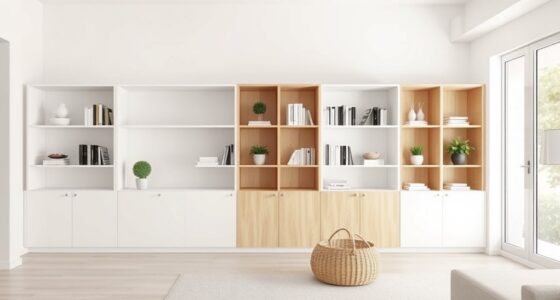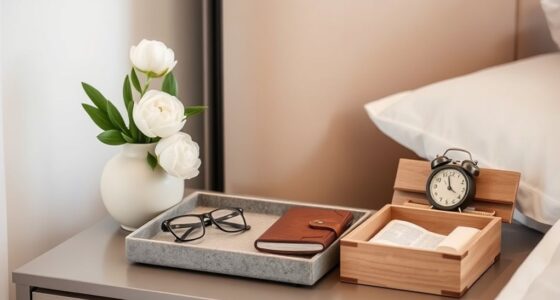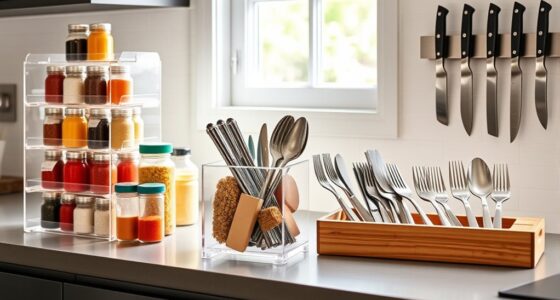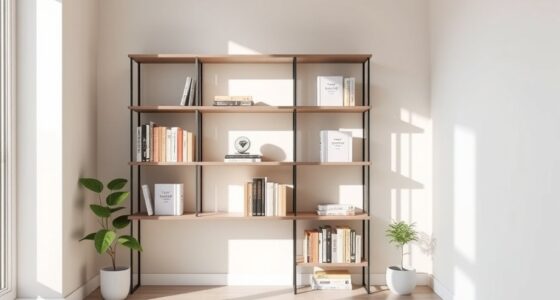If you're looking to create your ultimate chaos-free zone, I've got six must-have finds that'll transform your space. Start with the *Doable Decluttering Workbook* for guidance and motivation. Check out the *Sentimental Persons Guide* for help managing emotional attachments. Explore quick tips in *Decluttering Advice: Easy Ways to Reduce Stress*, and get practical steps in *Decluttering Workbook: The Essential Guide*. For a holistic approach, try *Decluttering Mastery: 3 Books in 1*. Stick around to discover even more tips!
Key Takeaways
- Utilize modular storage solutions that adapt to your changing needs and maximize available space effectively.
- Implement the "one in, one out" policy to manage incoming items and maintain a clutter-free environment.
- Choose eco-friendly storage options made from recycled materials to promote sustainability while organizing.
- Regularly schedule decluttering sessions to stay proactive and prevent clutter accumulation in your space.
- Embrace multi-functional storage solutions that serve dual purposes, enhancing both organization and efficiency.
Doable Decluttering Workbook for Home Organization
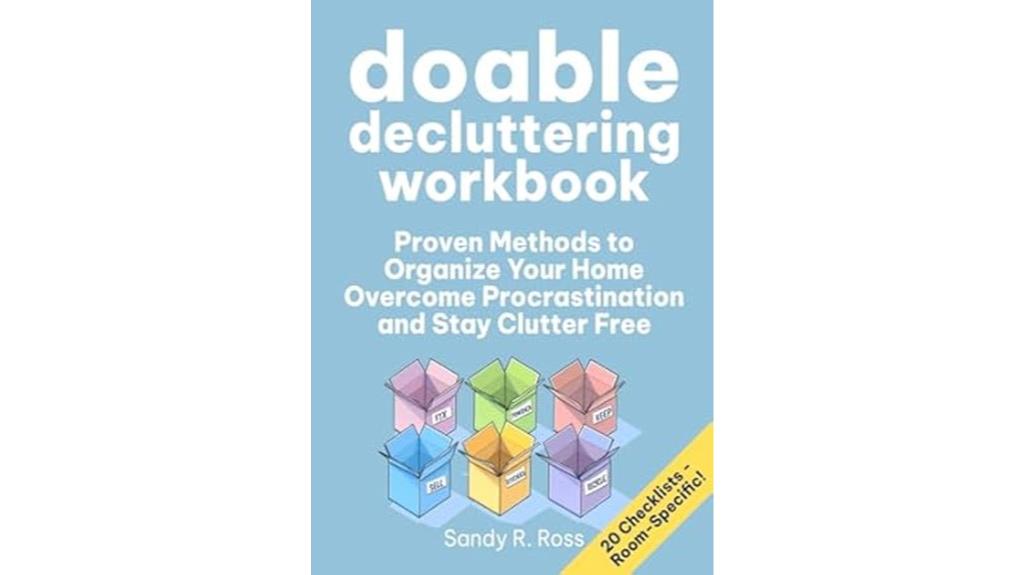
If you're someone who feels overwhelmed by clutter yet yearns for a more organized home, the "Doable Decluttering Workbook" is a fantastic choice for you. This workbook guides you through a step-by-step process, making it easy to see your progress with before-and-after comparisons. I love how it addresses emotional ties to belongings while offering compassionate advice. The 6-Box System and room checklists break the task into manageable parts, so you won't feel lost. Plus, the flexibility allows you to adapt the strategies to suit your needs. Trust me, this workbook can transform your space and mindset!
Best For: Individuals who feel overwhelmed by clutter and seek a structured, compassionate approach to home organization.
Pros:
- Step-by-step guidance allows for easy tracking of progress with before-and-after comparisons.
- Compassionate advice helps address emotional connections to belongings, making decluttering feel respectful and manageable.
- Flexible strategies can be adapted to individual preferences, allowing users to go at their own pace.
Cons:
- Some users may find certain tips less applicable to their specific situations or preferences.
- The workbook may require time commitment, which could be challenging for those with busy schedules.
- Initial emotional resistance may hinder the decluttering process for some individuals, making it harder to start.
Decluttering Advice: Easy Ways to Reduce Stress and Declutter Your Home
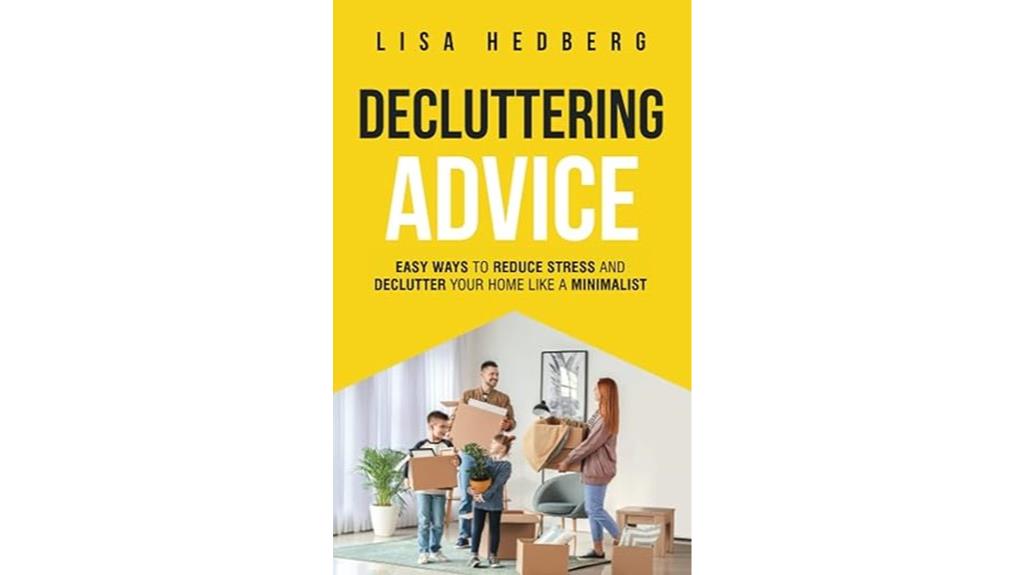
"Decluttering Finds" is an ideal choice for anyone feeling overwhelmed by the chaos of their living space, especially those who want practical strategies to simplify their lives. I found Lisa Hedberg's book incredibly helpful. By focusing on one room at a time, I could tackle clutter without feeling swamped. Her relatable experiences made me feel understood, and the exercises encouraged me to reflect on what I truly need. The Key Takeaways at each chapter's end provided quick references that I loved. I felt empowered to let go of items I no longer wanted, reducing my stress and creating a more organized home.
Best For: Individuals feeling overwhelmed by clutter who seek practical strategies to simplify their lives and create an organized living space.
Pros:
- Provides step-by-step instructions for decluttering one room at a time, making the process manageable.
- Offers relatable personal experiences and emotional support, helping readers feel understood and motivated.
- Includes Key Takeaways at the end of each chapter for quick reference and actionable advice.
Cons:
- Some readers find the format could be improved with the use of bullet points and pull-out quotes for easier navigation.
- A desire for a more visual guide is noted, as some prefer quick, actionable advice presented visually.
- There are suggestions for more original ideas, as some content overlaps with existing decluttering literature.
The Sentimental Persons Guide to Decluttering
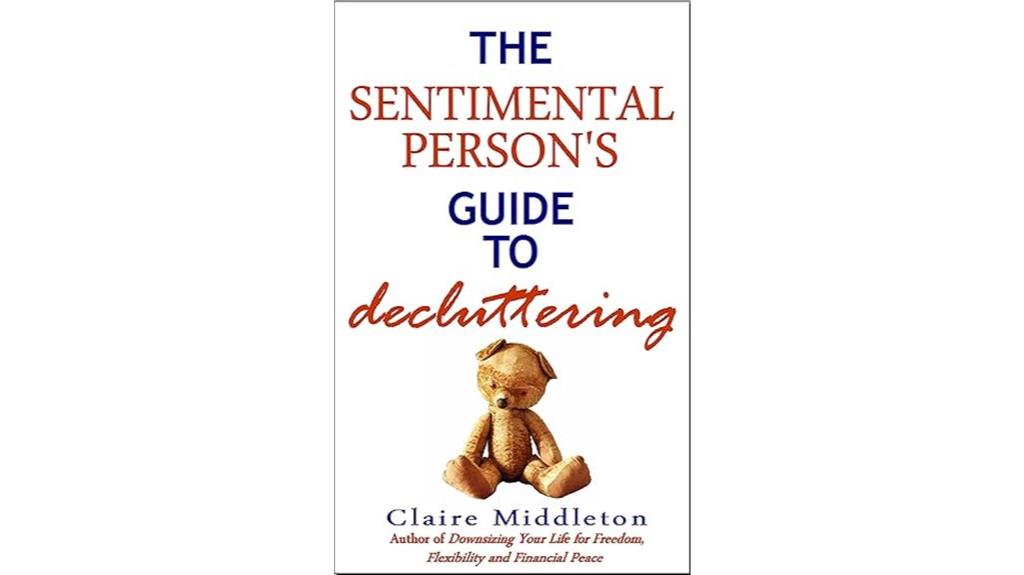
For those of us who find it difficult to part with possessions that carry sentimental value, "The Sentimental Persons Guide to Decluttering" offers a compassionate and practical approach. The author provides relatable strategies for downsizing and organizing our cherished items. I love the idea of grouping similar belongings, which helped me evaluate what truly matters. This book encourages us to confront the guilt of letting go, making the emotional process easier. Many readers, including myself, found renewed motivation to take control of our clutter. If you're struggling with sentimentality, this book is a must-have reference for simplifying your space.
Best For: Individuals who struggle with letting go of sentimental possessions and seek a compassionate, practical approach to decluttering.
Pros:
- Provides relatable strategies for downsizing and organizing sentimental items.
- Encourages readers to confront emotional guilt associated with letting go of possessions.
- Inspires motivation to take action and regain control over cluttered spaces.
Cons:
- Some readers may find the content basic and lacking new strategies.
- The emotional approach may not resonate with those who prefer a more straightforward, practical method.
- Limited appeal for individuals who do not struggle with sentimentality in their belongings.
Decluttering Workbook: The Essential Guide to Organize and Declutter Your Home
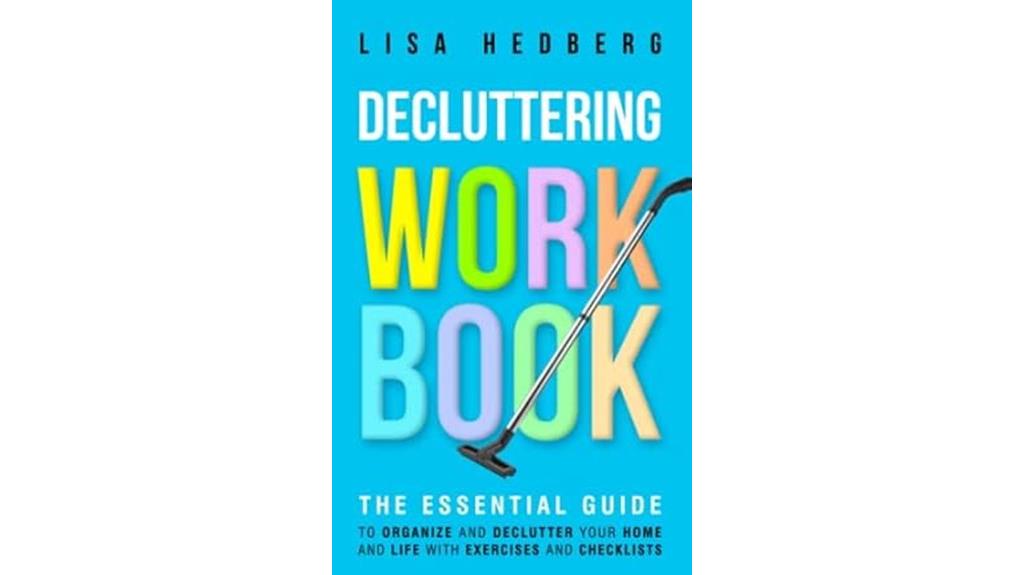
Finding a reliable resource for organizing and decluttering can feel overwhelming, especially if you're not sure where to start. I found Lisa Hedberg's *Decluttering Workbook* to be an essential guide that breaks down the process into manageable steps. With simple language and relatable personal experiences, it truly resonates with anyone struggling with clutter. The workbook encourages quick tasks that fit into your day, promoting self-reflection to address mental barriers. Plus, practical exercises and tools help set achievable goals. I highly recommend this workbook for anyone ready to embrace a more organized, clutter-free life. You won't regret it!
Best For: Individuals seeking a relatable and structured approach to decluttering and organizing their home and life.
Pros:
- The workbook offers practical, manageable steps that can be completed in short time frames.
- It emphasizes self-reflection and addresses psychological barriers to clutter, promoting a healthier mindset.
- Readers appreciate the conversational tone and empathetic approach, making the material easy to digest.
Cons:
- Some readers may need to purchase additional organizational tools, which could contradict the goal of reducing clutter.
- The focus on self-reflection might not resonate with everyone, particularly those looking for straightforward organizing methods.
- A few users might find the exercises time-consuming if they are already overwhelmed with clutter.
Decluttering Mastery: 3 Books in 1
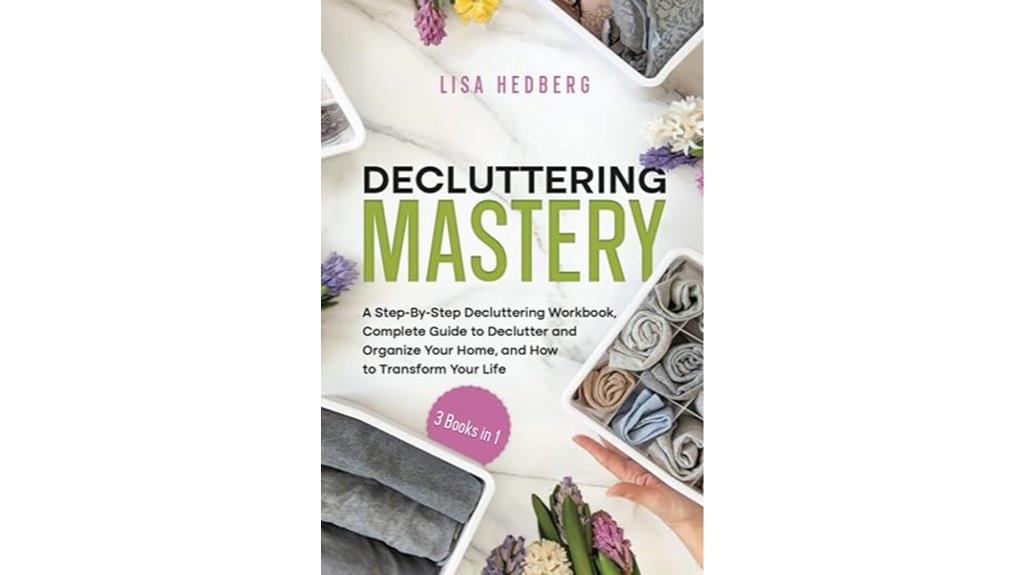
If you're feeling overwhelmed by clutter and want a guided approach to reclaim your space, "Decluttering Mastery: 3 Books in 1" is the perfect companion. This thorough guide provides step-by-step instructions and practical strategies, making the decluttering process approachable and manageable. I found the engaging format and supportive insights felt like having a friend by my side. The book's holistic view encourages self-reflection on your attachments to items, helping you let go of what no longer serves you. With tools like checklists and the five-second rule, you'll feel empowered to create a harmonious, clutter-free environment.
Best For: Individuals seeking practical guidance and support in decluttering their living spaces and lives.
Pros:
- Engaging and motivational format that feels like having a supportive friend.
- Offers practical strategies and tools, such as checklists and the five-second rule, to make decluttering manageable.
- Encourages self-reflection on personal attachments, empowering readers to let go of items that no longer serve them.
Cons:
- Some readers suggest including photographs of organized spaces for better visual guidance.
- Minor formatting complaints may affect the reading experience for some.
- Lacks before-and-after comparisons that could enhance motivation and visualization of outcomes.
Unclutter Your Life: A Proven System to DeClutter Your Home and Schedule
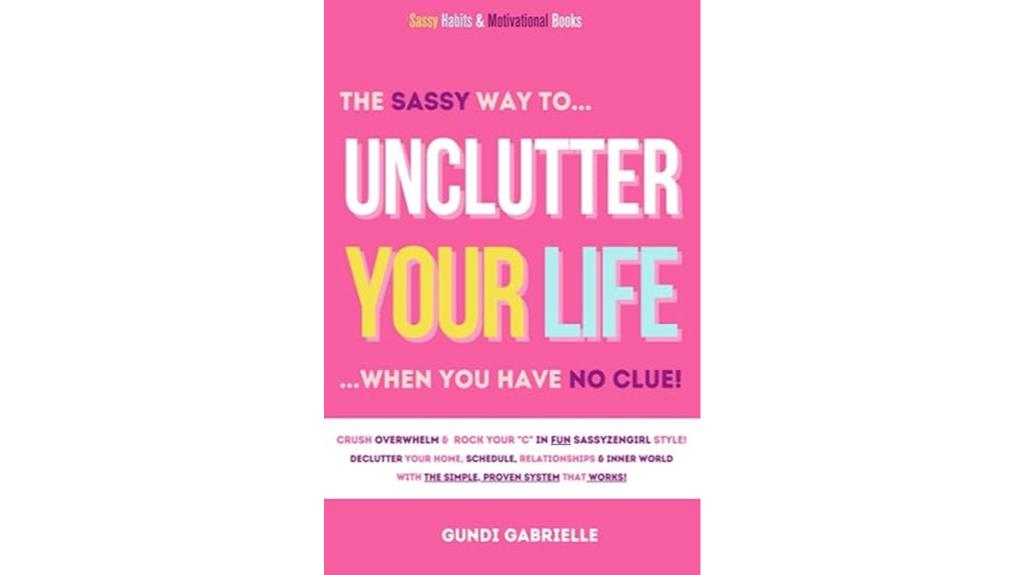
Unclutter Your Life: A Proven System to DeClutter Your Home and Schedule is perfect for anyone feeling overwhelmed by their possessions and daily commitments. I found the psychological insights particularly helpful, as they address the emotional roots of clutter. The author's gentle approach helped me confront my procrastination without judgment. I loved the practical tips and resources for selling unwanted items, which made decluttering feel manageable. The engaging style kept me motivated, turning what I once saw as a chore into an exciting journey. Ultimately, this book inspired me to simplify my life and embrace a clutter-free mindset.
Best For: Individuals feeling overwhelmed by clutter and looking for a compassionate, practical approach to decluttering their home and schedule.
Pros:
- Provides psychological insights that address the emotional roots of clutter, fostering a supportive mindset.
- Offers extensive practical tips and resources for selling unwanted items, making decluttering manageable.
- Engaging and conversational writing style that turns decluttering into an enjoyable journey rather than a chore.
Cons:
- Some readers may find the psychological aspects less relevant if they are primarily seeking practical solutions.
- The abundance of resources and links might be overwhelming for those who prefer a more streamlined approach.
- Not all readers may resonate with the author's style, which could impact their engagement with the content.
Factors to Consider When Choosing The Decluttering Finds for a Chaos-Free Zone
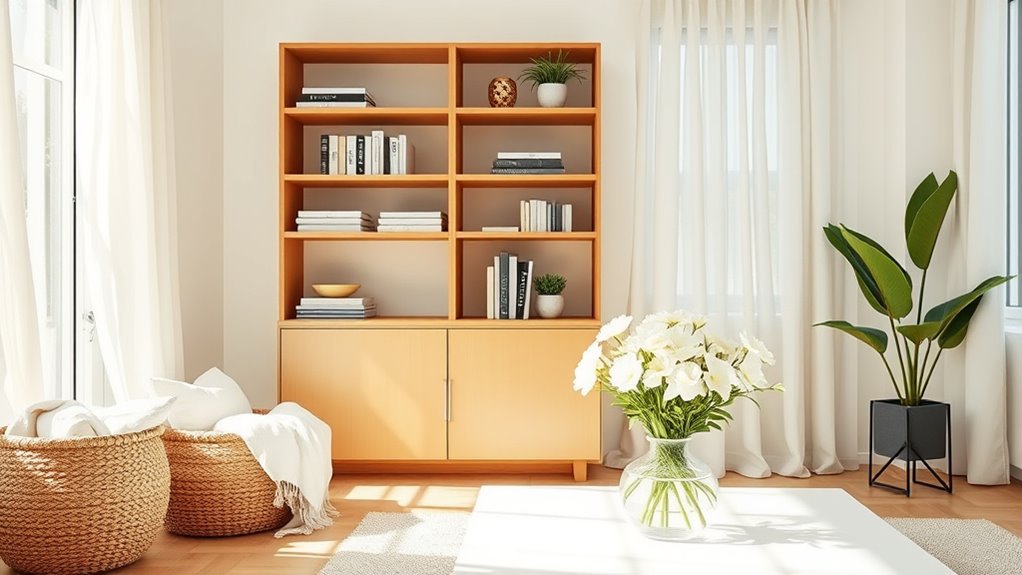
When I'm choosing what to keep for a chaos-free zone, I always start by evaluating my space needs. It's essential to identify clutter hotspots and prioritize items that truly serve a function. Aesthetic preferences and effective storage solutions also play a big role in creating a harmonious environment.
Assess Your Space Needs
Have you ever considered how the layout of your space affects your ability to keep it clutter-free? I've found that evaluating the size and arrangement of each room is essential. It's important to determine how much clutter I can realistically manage without overwhelming the space. I prioritize decluttering in high-traffic areas like my living room and kitchen since clutter can hinder daily activities. Reviewing my storage options also influences what I can keep organized. I pay extra attention to areas like closets, which often have different space needs. Finally, I consider my personal lifestyle and how I use each space. This guarantees my decluttered environment meets my practical needs and enhances my daily living experience.
Identify Clutter Hotspots
Where do you find clutter accumulating the most in your home? For me, it's often the entryway and my living room. By observing these areas, I can see where items pile up, making my space feel chaotic. I've noticed that inadequate storage solutions and procrastination in deciding what to keep are common triggers for clutter hotspots. Emotional attachments to certain belongings also make it hard to let go. Regularly evaluating these clutter-prone areas has helped me stay proactive in keeping my home organized. To combat this, I've started using designated storage solutions and scheduling routine decluttering sessions. These strategies greatly reduce clutter accumulation, creating a more calming and functional environment.
Prioritize Functional Items
As I tackle my decluttering process, I realize that prioritizing functional items is essential to creating a chaos-free zone. Each possession should serve a purpose, which helps reduce unnecessary clutter and enhances the efficiency of my living space. I focus on items that have multiple functions, maximizing utility while minimizing storage needs. Considering how often I use certain items is significant; regularly used objects should remain accessible and practical. I also evaluate the quality and durability of these functional finds, knowing that investing in well-made products leads to long-term satisfaction and less replacement clutter. Finally, I keep my current lifestyle in mind—my needs can change, and that determines which items I keep or discard.
Consider Aesthetic Preferences
While decluttering, I've discovered that considering my aesthetic preferences greatly impacts my ability to maintain an organized space. When I choose storage solutions that match my existing decor, the room feels cohesive and inviting. I find that color coordination and design themes create a harmonious environment, easing the stress clutter often brings. For example, using decorative baskets or stylish organizers not only serves a functional purpose but also enhances the overall look. Personalizing my storage with colors and textures that resonate with me fosters a deeper emotional connection, motivating me to keep things tidy. Ultimately, when my space reflects my taste, I'm more likely to maintain that chaos-free zone I crave.
Evaluate Storage Solutions
When it comes to evaluating storage solutions, I always focus on five key factors that can transform a cluttered space into a serene environment. First, I assess the available space to find solutions that maximize efficiency without overwhelming the area. Next, I look for modular options that can adapt as my storage needs change. Accessibility is essential too; I want frequently used items within easy reach. I also prioritize multi-functional storage, like furniture with built-in compartments, to reduce clutter while keeping the aesthetic intact. Finally, I examine the durability and quality of materials to guarantee they'll last long-term, contributing to a sustainable living space. By considering these factors, I create an organized and chaos-free zone.
Budget for Organization Tools
Budgeting for organization tools is essential if I want to create a clutter-free space without overspending. I usually allocate about 10-20% of my overall decluttering budget for these tools to guarantee I have enough resources. Investing in quality items saves money in the long run, reducing the need for replacements. I always make a detailed list of necessary tools, focusing on those that'll make the biggest impact on my space. To stretch my budget, I take advantage of sales, discounts, and even second-hand options. Plus, I remember to factor in additional costs like shipping or delivery fees to avoid unexpected expenses. This way, I can efficiently create my ultimate chaos-free zone.
Embrace Flexibility and Adaptability
Embracing flexibility in my decluttering journey not only makes the process more enjoyable but also guarantees it fits my unique lifestyle. I've learned that adapting my approach allows me to experiment with various strategies, discovering what truly works for me. This adaptability helps reduce feelings of overwhelm; I can set my own pace and adjust my goals whenever necessary. I appreciate that not every decluttering tip resonates with me, so I focus on what empowers my organization efforts. By adapting techniques to different areas, like digital spaces or emotional attachments, I create a more thorough and fulfilling decluttering experience. Ultimately, embracing this flexibility fosters a positive mindset, making the journey feel less like a chore and more like a personal transformation.
Seek Sustainable Options
As I dive deeper into decluttering, I realize that seeking sustainable options not only benefits my space but also the planet. Instead of tossing items into landfills, I focus on donating, recycling, or repurposing them. Choosing eco-friendly storage solutions made from recycled or renewable materials minimizes my environmental impact while keeping things organized. I've also adopted a "one in, one out" policy, ensuring that for every new item I bring home, I let go of an old one. Supporting local charities is another way I give usable items a second life, helping my community. Finally, I emphasize quality over quantity, opting for longer-lasting items that reduce clutter and contribute to a sustainable lifestyle.
Frequently Asked Questions
How Do I Start Decluttering if I'm Overwhelmed?
If you're feeling overwhelmed by clutter, I totally get it. I start small by picking one area, like a drawer or a corner. I set a timer for 15 minutes, so it feels manageable. I ask myself if each item serves a purpose or brings me joy. If not, I let it go. Breaking it down into tiny tasks makes decluttering feel less intimidating and helps me see progress quickly!
What Are the Best Storage Solutions for Small Spaces?
When I'm tackling storage solutions for small spaces, I love using multi-functional furniture. For instance, ottomans with hidden compartments or beds with drawers underneath really maximize space. I also find that wall shelves help keep items off the floor while adding a decorative touch. Baskets and bins in closets are lifesavers too; they keep everything organized and easy to find. With a bit of creativity, even tiny spaces can feel spacious and functional!
How Often Should I Declutter My Home?
I find that decluttering every few months keeps my home feeling fresh and organized. I usually set aside a day every season to assess what I truly need. However, I also tackle smaller areas, like a drawer or closet, whenever I notice it getting cluttered. It's amazing how just a little regular maintenance can prevent chaos from building up. Trust me, keeping it simple makes a huge difference in my space!
Can I Declutter With Children in the House?
Absolutely, you can declutter with children around—it's like trying to herd cats, but it's possible! I've found that involving my kids makes the process fun and teaches them valuable lessons. We set aside time together, turning it into a game. I let them choose what to keep or donate, making them feel empowered. Sure, it can get messy, but with a little patience, you can create a more organized space for everyone.
What to Do With Items I No Longer Want?
When I find items I no longer want, I usually start by sorting them into categories. I'll set aside things to donate, sell, or recycle. If it's in good condition, I consider taking it to a local charity or posting it online. For items that don't hold value, I often just toss them. It's freeing to let go, and I love knowing someone else might benefit from what I no longer need.
Conclusion
In my quest for a calm, clutter-free space, I've discovered that the right resources can truly transform your home. Whether it's a workbook, a guide, or a mastery manual, each tool offers unique insights to simplify your surroundings. So, let's embrace these decluttering discoveries and design a delightful, de-stressed domain. Remember, creating your chaos-free zone is a journey, not a sprint. Let's take it step by step, and soon, we'll savor the serenity of our serene spaces!


